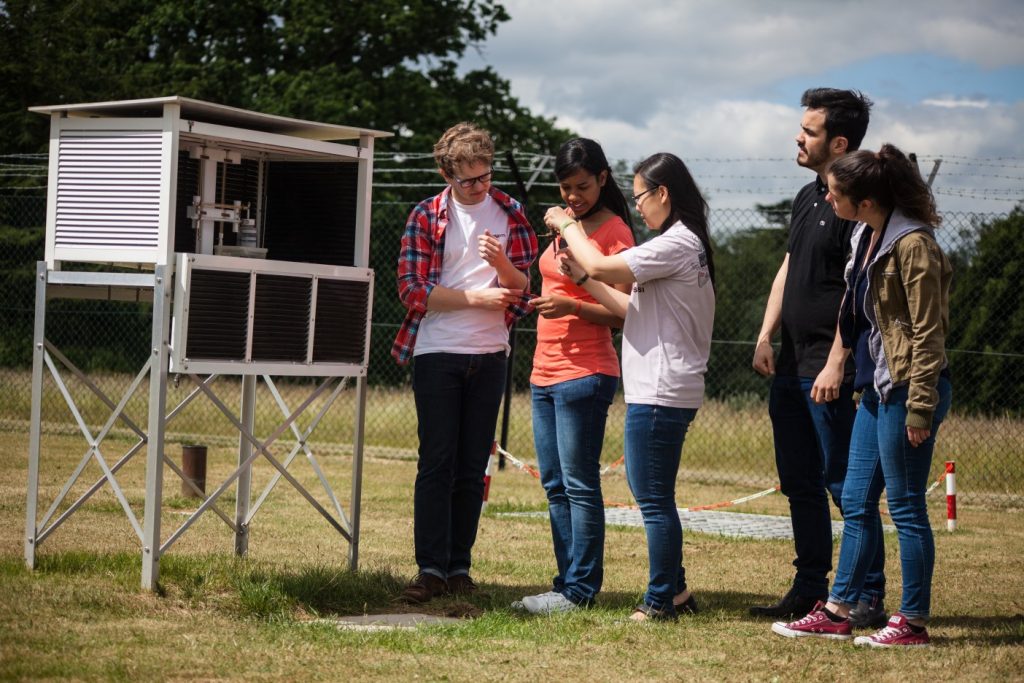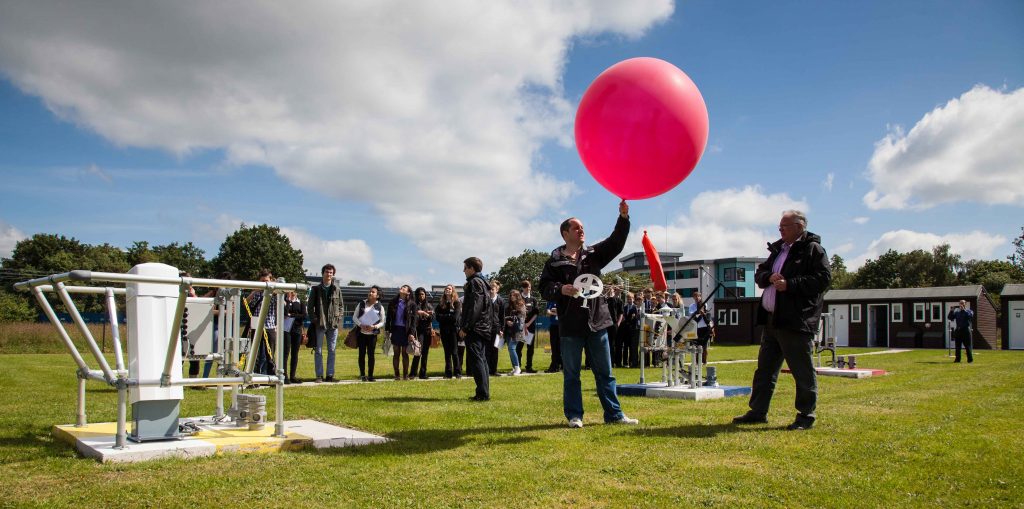Resources
Year 10 Meteorology Day | Radiosonde balloon data and slides (2013)
University of Reading Atmospheric Observatory
Key Stage 3/4 resources for environmental physics and storm research
Year 3 schools weather activities (Robin Hogan)
IPCC climate science updates for teachers | Modelling Climate Change | Links
Learn about our undergraduate courses including the new BSc Physics of the Environment (further information)
OPENER – opening up science for all – a new NERC Public Engagement project led by the University of Reading
Unfortunately the Work Experience Programme is currently not running
How do we predict weather and climate?

The resources below were developed for an Open Day for Key Stage 3/4 pupils during National Science and Engineering Week 2009. You can download follow-up activity sheets below and also look at radiosonde balloon launch data and slides from 2013.
Classroom activities:
In this activity students learn how vital observations are to understand and the predict the weather. Students learn about surface observations and measurements taken from weather balloons that give scientists information about the vertical structure of the atmosphere. 
In this activity, students observed and measured the properties of density currents. The aim of the activity was to teach students how fluids of differing densities interact with one another and to learn how the density of fluids can be changed.
The Richardson forecast factory
During a Department open day in March 2009, students were asked to imagine themselves as ‘human computers’ in a vast forecast factory. This idea was originally conceived by one of the pioneers of numerical weather forecasting, Lewis Fry Richardson. Today, most weather forecasts run along similar lines, although the computers are digital and housed in large supercomputing centres. 
The aim of the activity was to introduce students to the ways in which numerical weather forecasts are made using a very simple, advection equation. The real, forecasting equations are much more complex and harder to solve.
The Reading University Meteorology Observatory
 The Meteorology Department Recently held a staff lunch on the Atmospheric Observatory site to celebrate the recent complete refurbishment of the Observatory site and buildings.
The Meteorology Department Recently held a staff lunch on the Atmospheric Observatory site to celebrate the recent complete refurbishment of the Observatory site and buildings.
 The Atmospheric Observatory was established at its current site on Whiteknights Campus in 1968 where continuous measurements have since been gathered daily. The site is used for routine weather observations but also increasingly for a range of research instrumentation, both for continuous monitoring and portable equipment testing for both Meteorology Department staff and collaborators from other organisations (see recent material on Observatory). The site is also used extensively for teaching and outreach events.
The Atmospheric Observatory was established at its current site on Whiteknights Campus in 1968 where continuous measurements have since been gathered daily. The site is used for routine weather observations but also increasingly for a range of research instrumentation, both for continuous monitoring and portable equipment testing for both Meteorology Department staff and collaborators from other organisations (see recent material on Observatory). The site is also used extensively for teaching and outreach events.

The site was badly in need of repair and refurbishment by 2011, with regular flooding of the area and buildings and insufficient space for student projects. Work was started in summer of 2012 involving demolishing old buildings and building a new base and drainage for 2 new huts giving expanded work space and improved power and data connectivity including wireless across the whole site, along with extensive replacement of many of the instrument mounts. The Observatory was back in regular use early in 2013. The department is very grateful for support from the Facilities Management directorate as well as the Science Faculty for supporting the refurbishment costs, as well as the tireless efforts of the Technicians team who had to prepare and oversee the building works and get everything back into working order afterwards. With new research instruments currently being installed such as a cloud LIDAR, and plans for a larger instrument development program as part of the University’s new Environmental Physics degree (from 2014) the Observatory now has a great future ahead.
Environmental Physics Degree
Some powerpoint slides outlining our Physics of the Environment Degree:
General Information
Careers slides
DIAMET schools KS3/4 resources
 DIAMET is an atmospheric sciences research project involving the University of Reading and other UK Universities in partnership with the Met Office and the National Centre for Atmospheric Science. A variety of resources and activities have been produced by the project that are suitable for Key Stage 3 and Key Stage 4 science. The resources all make use of DIAMET research, weather forecasting and our atmosphere as engaging contexts for learning.
DIAMET is an atmospheric sciences research project involving the University of Reading and other UK Universities in partnership with the Met Office and the National Centre for Atmospheric Science. A variety of resources and activities have been produced by the project that are suitable for Key Stage 3 and Key Stage 4 science. The resources all make use of DIAMET research, weather forecasting and our atmosphere as engaging contexts for learning.
Modelling Climate Change
 The Walker Institute has prepared a booklet on Modelling Climate Change as part of the “Innovations in Practical Work” series published by the Gatsby Science Enhancement Programme (SEP).
The Walker Institute has prepared a booklet on Modelling Climate Change as part of the “Innovations in Practical Work” series published by the Gatsby Science Enhancement Programme (SEP).
This includes activity sheets, powerpoint presentations and computer spreadsheets which include practical experiments, simple examples of climate modelling, and analysis of observed data and is aimed at ages 14-19. Read more…
See also these examples of high resolution climate simulations by Pier Luigi Vidale on behalf of a University of Reading / NCAS / Met Office (HRCM/JCWRP/NERC) collaboration:
IPCC updates for schools
An RMetS/NCAS project, including the University of Reading, that provides updated resources on climate change for teachers of GCSE Science and Geography and A-level Geography.
- Resources designed for the new A-Level Geography specifications for 2016.
- GCSE resources for Geography teachers and Science teachers. Resources use the latest scientific assessment of climate change generated from the Intergovernmental Panel on Climate Change 5th assessment report (see also Frequently Asked Questions and a list of IPCC figures considered).
Contact us
- Telephone
+44 (0)118 378 8950 - Full details
- Visiting the University
Visit the Department:
Department of Meteorology
University of Reading
Brian Hoskins Building
Whiteknights Road
Earley Gate
Reading
Berks RG6 6ET
Please use the Satnav postcode RG6 7BE for the Earley Gate entrance.

